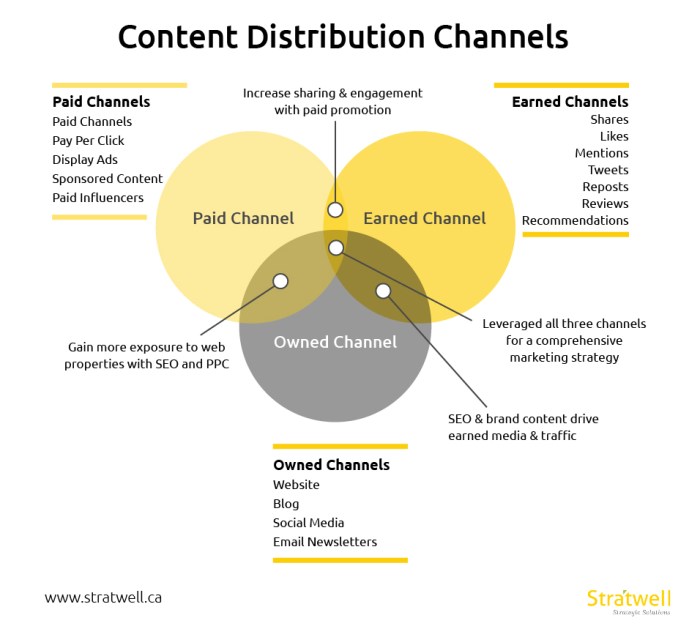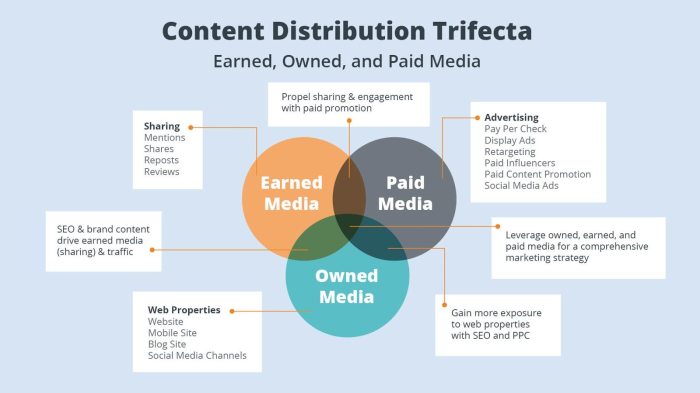Content Distribution Channels, a key aspect of digital marketing, play a vital role in reaching and engaging with your target audience effectively. By exploring various distribution strategies and emerging trends, you can elevate your content game to new heights.
Overview of Content Distribution Channels
In the digital age, content distribution channels refer to the various platforms and mediums used to share and disseminate content to a wide audience. These channels play a crucial role in reaching target audiences, increasing visibility, and driving engagement.
Utilizing multiple content distribution channels is essential for maximizing reach and impact. By diversifying the channels through which content is shared, content creators can cater to different audience preferences and behaviors. This approach helps in capturing the attention of a broader demographic and ensures that the message reaches a larger number of potential viewers.
Popular Content Distribution Channels
- Social Media Platforms: Platforms like Facebook, Instagram, Twitter, and LinkedIn are popular channels for sharing content due to their vast user base and extensive reach.
- Video Hosting Sites: Platforms such as YouTube, Vimeo, and TikTok are ideal for distributing video content, reaching audiences who prefer visual storytelling.
- Email Marketing: Utilizing email newsletters and campaigns is an effective way to distribute content directly to subscribers’ inboxes, allowing for personalized communication.
- Content Aggregators: Platforms like Reddit, Medium, and Flipboard aggregate content from various sources, providing a platform for curated content distribution.
Types of Content Distribution Channels

When it comes to distributing your content, there are various types of channels that you can leverage to reach your target audience. Each type of channel has its own set of advantages and disadvantages, so it’s important to choose the right ones based on your content type and the audience you are trying to reach.
Social Media
Social media platforms like Facebook, Instagram, Twitter, and LinkedIn are great for sharing content with a wide audience quickly. They allow for easy engagement with followers through likes, comments, and shares. However, the organic reach of posts on social media can be limited, and algorithms may affect how many people see your content.
Email Newsletters
Email newsletters are a more direct way to reach your audience as they land directly in their inbox. This type of channel allows for personalized communication and can be used to nurture leads or maintain relationships with existing customers. On the downside, open rates for emails can vary, and it’s important to avoid coming off as spammy.
Blogs
Blogs are a great way to provide in-depth content to your audience and establish yourself as a thought leader in your industry. They can also help with search engine optimization () and drive traffic to your website. However, maintaining a blog requires consistent effort in creating quality content, and it may take time to build a loyal readership.
Choosing the Right Channels
When deciding on the right distribution channels for your content, consider the type of content you are creating and the preferences of your target audience. For example, if you are targeting a younger audience, platforms like Instagram or TikTok may be more effective, while a B2B audience might prefer LinkedIn or email newsletters. It’s important to test different channels and analyze the results to see what works best for your specific content and audience.
Strategies for Effective Content Distribution

In the digital age, having a solid content distribution strategy is key to reaching your target audience and maximizing engagement. Here are some best practices to optimize your content distribution across various channels:
Utilize Multiple Channels
To effectively reach a wider audience, it’s crucial to distribute your content across multiple channels such as social media platforms, email newsletters, blogs, and third-party websites. This not only increases your reach but also diversifies your audience base.
Consistent Branding and Messaging
Maintaining consistency in branding and messaging across all your content distribution channels is essential for building brand recognition and trust. Make sure your tone, style, and visuals are cohesive to create a unified brand experience for your audience.
Personalize Content for Different Platforms, Content Distribution Channels
Each content distribution channel has its own unique audience demographics and preferences. Tailor your content to suit the specific platform you’re using. For example, create shorter, visually appealing content for platforms like Instagram, and longer, more informative content for blogs.
Monitor and Analyze Performance
Regularly monitor the performance of your content across different channels using analytics tools. Identify which channels are driving the most engagement and adjust your distribution strategy accordingly. This data-driven approach will help you optimize your content distribution for better results.
Engage with Your Audience
Don’t just distribute your content and walk away. Engage with your audience by responding to comments, messages, and mentions. Building a relationship with your audience fosters trust and loyalty, leading to increased engagement and brand advocacy.
Emerging Trends in Content Distribution
In today’s ever-evolving digital landscape, content distribution channels are constantly adapting to new trends and technologies to reach wider audiences and engage users in more innovative ways. Let’s dive into some of the emerging trends shaping the future of content distribution.
Influencer Marketing
Influencer marketing has become a powerful tool for brands to connect with their target audience through trusted and relatable influencers. By partnering with influencers who have a loyal following, brands can reach a larger audience and drive engagement with authentic content that resonates with consumers.
Video Platforms
Video content continues to dominate the digital space, with platforms like YouTube, TikTok, and Instagram Reels gaining popularity among users. Brands are leveraging video platforms to create engaging and shareable content that tells a story and connects with viewers on a deeper level. The rise of live streaming and short-form video content has revolutionized the way brands distribute their message to consumers.
Impact of AI and VR
Artificial Intelligence (AI) and Virtual Reality (VR) technologies are revolutionizing content distribution strategies by offering personalized experiences and immersive storytelling. AI-powered algorithms help brands analyze data and optimize content distribution for maximum impact, while VR technology allows users to interact with content in a more immersive and engaging way. These technologies are reshaping the future of content distribution by making it more interactive, personalized, and memorable for consumers.
Future Prospects
As technology continues to advance, the future of content distribution channels looks promising. With the rise of AI, VR, and other innovative technologies, brands have the opportunity to create more personalized and engaging content that resonates with their target audience. By staying ahead of emerging trends and leveraging new technologies, brands can adapt their content distribution strategies to meet the evolving needs and preferences of consumers in the digital age.












